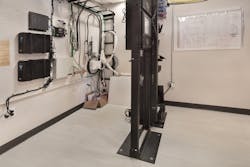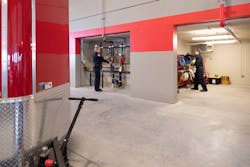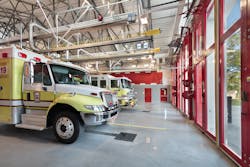Station Design: Station Construction: Budgeting for Soft Costs
To understand what soft costs are, it is important to first understand what constitutes the total project cost for a new fire station: hard costs, owner contingencies and soft costs.
Hard costs are the brick-and-mortar expenses that cover all of the fixed construction elements of the project. They usually account for approximately 60 percent–80 percent of total cost. Items that are included are: site development costs; concrete and steel; the building envelope; interior finishes; building systems; and design contingencies and construction escalation.
Owner contingency is money that’s set aside for “unforeseen conditions,” owner-requested changes and design modifications that surface while the building(s) are under construction. Owner contingency costs account for approximately 3 percent–8 percent of the budget.
Soft costs are the nonconstruction costs to design, furnish, document and finance the project. They usually account for approximately 10 percent–30 percent of a project budget. There are eight categories of soft costs: professional services; fixtures, furniture and equipment (FF&E); special fees; financing costs; insurance; in-house staff costs; surveys; and land costs.
Note: These budget guidelines are a rule of thumb to get you started. You still must do the difficult work that’s entailed in vetting the information, so you understand it well enough to defend it to the taxpayers.
Professional services
This category usually requires the largest budget among soft costs and includes four categories:
Architectural/engineering fee. For a new fire station project, the architect/engineering fee usually is established as a percentage of the construction costs. The higher the construction cost, the lower the percentage will be. (Many states have published fee guidelines for reference.) For example, the fee range for a new $5 million fire station would be 6.13 percent–9.21 percent. Percentages typically are higher for renovation work.
Feasibility and master plan studies. This is a great way to start to define the size and cost of any potential project, particularly when multiple sites are involved. Fees vary widely by the scope of work that’s required, ranging from $5,000–$100,000. A typical number might be $30,000.
Building commissioning. Commissioning engineers engage in pre-occupancy testing of facilities and mechanical equipment, to ensure that the facilities/equipment function correctly and produce the expected results. (Services are required by code in most parts of the country.) Costs depend on the scope, size and complexity of systems, ranging from $1.20–$3.50 per square foot.
Materials/construction inspection. This expense covers required code inspections, such as soil-bearing capacity, concrete strength, rebar placement, fire-resistive materials and seismic design components. You should budget between 0.25 percent–0.75 percent of hard costs.FF&E
FF&E is composed of furniture, fixtures and equipment that have no permanent connection to the structure of a building or to its utilities.
Fire station furniture includes office furniture and living space furniture, including bunks, mattresses, dining tables and recliners. Equipment includes copiers, printers, fitness equipment and appliances that are located in the living area, such as refrigerators, ranges, dishwashers, microeave ovens, and residential washers and dryers. Don’t forget plates, glassware, knives, and pots and pans.
Specialized firehouse equipment might include physical training equipment (a maze, smoke generators and digital-attack equipment); turn-out equipment (PPE lockers, gear drying systems and washer/extractors); SCBA equipment (workbenches, bottle storage racks and compressors/fill stations); and maintenance shop items (tool boxes, parts and hardware cabinets, workbenches and rolling hose racks).
Furniture and equipment budgets vary by quality and quantity, with a target budget of $15–$30 per square foot of the facility. Add a budget category if you must move furniture and another if you plan to display historical pictures or antiques.
Budget $1,500 for typical conference room equipment and as much as $40,000 for large gathering rooms. For a standard fire station, estimate $50,000 for the computer equipment racks, servers, patch panels, switches, Wi-Fi hotspots, cellphone repeaters, security cameras, access control systems, telephone handsets and desktop computers.
Your fire station alerting system might be minimal for a volunteer department or fully featured for a busy urban facility. Costs can exceed $100,000, but most installations will be somewhat less.
Special fees can include permit and inspection fees, utility hook-up fees and LEED certification. If you are the municipality, you can waive your own permit and inspection fees unless you contract for these services. If you provide your own utilities, the same idea applies, but if not, contact the utilities for their fee structure. For LEED certification of the project, target a budget of $150,000.
Include approximately $2,000 for legal notices, mailing information about the project to neighbors, installation of a large sign at the future location, printing sets of documents for permit review and similar things.
If you finance the project, the cost of selling bonds will include the underwriter commission, financial advisor fee, bond counsel, rating agency fee, verification agent fee, escrow fee agent and printing and the fee for Committee on Uniform Securities Identification Procedures (CUSIP).
A recommended insurance policy for new construction is a Builders Risk Insurance policy. It covers damage to the building during construction that might arise from the negligence of contractors and/or certain “acts of God.” Use 1.0 percent of the hard costs as a starting budget.
The cost of in-house staff almost never is considered; however, your staff’s time is important for the success of the project. For instance, you might have a firefighter committee that would be paid overtime to attend meetings. The most time spent will be in project coordination, design review meetings, construction meetings, any self-performed construction work (firefighters who install PPE lockers) and any community meetings. Larger organizations might have to budget for staff from other departments to participate in the project.
The costs of surveys can include site surveys (boundary, utility, topographic) and geotechnical engineering. For best value, combine site surveys into one and budget approximately $5,000. Soil-boring costs depend on how many that you need and how deep that you go, which varies based on local geology. A local geotechnical engineer can help you to budget.
When it comes to land costs, if you purchase new property, you must include not only the purchase price but any legal fees, appraisal, environmental assessments, survey costs and closing costs. If you sell property, you might be able to record a net positive number.
The numbers add up quickly
Total soft costs add up quickly and can lead to difficult questions from people who are unfamiliar with the process of building a fire station. A thorough breakdown can prove to doubters that the total project cost was prepared carefully and that taxpayer dollars are being spent wisely.
About the Author
Henry Pittner
Henry Pittner is a partner of BKV Group, which is a design firm that provides a full complement of architecture, engineering, interior design, landscape architecture and construction administration services. Pittner is an award-winning licensed architect, author and presenter who has gained national recognition for his leadership managing, programming, planning and designing governmental projects. With more than 35 years of experience, he has led more than 70 projects in 12 states for city, county and state clients.


